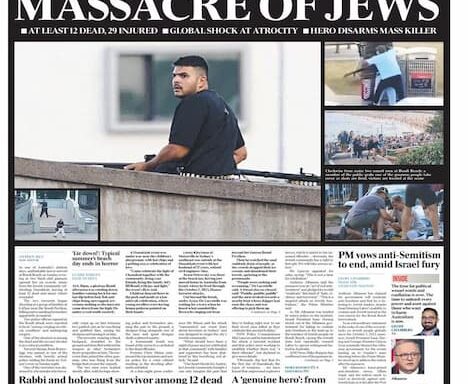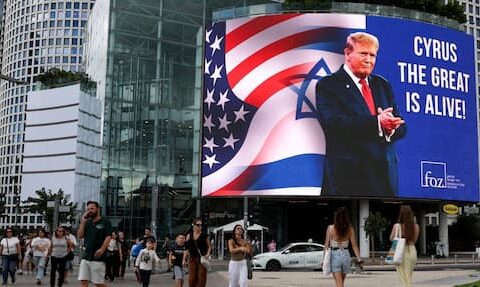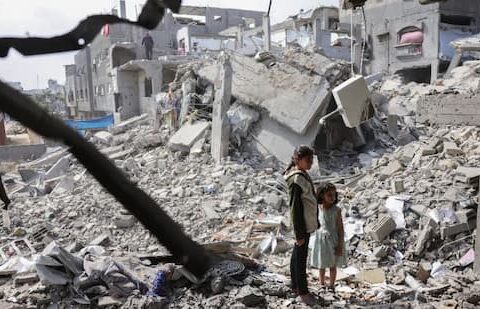
I was asked by Dr Leon Tressell to re-post this very lengthy article he recently published at SouthFront. In it, he provides a very thorough analysis of the situation now in Syria; and of the actions and motivations of the various players and power-blocs involved in the conflict and how the situation in Syria is likely to play out.
‘Do any these power blocs, that have carved out spheres of influence in northern Syria, offer a solution to the Syrian people’s desperate desire for peace and the reconstruction of their country?’ he asks.
Below is the full article, reproduced here with his permission, including the original images and maps.
__________________
The apparent collapse of Isis in northern and eastern Syria, as well as its impending eviction from Mosul in Iraq are celebrated by some commentators as the beginning of the end of the Syrian conflict.
However, it could be argued that the impending demise of Isis in Syria and Iraq represents merely the end of one phase of the Syrian conflict. One only has to look at the situation in northern Syria to realise that the eviction of Isis from that region in no way represents a victory for peace. Now that the Frankenstein monster, that was born out of the disastrous American led intervention in Iraq, has been routed in northern Syria, it becomes clear that the people of Syria now have to contend with a three way geopolitical conflict that is unlikely to bring peace, reconstruction and prosperity to the people of the region.
In northern Syria there are three power blocs that that are currently jockeying for position. They are driven by a variety of conflicting interests that will be difficult to reconcile in the next period.
On the one hand, there is the Syrian Arab Army supported by its Iranians sponsor, a variety of Shiite militias and propped up by the political/military clout of the Russian Federation. In the next corner are the Rojava Kurds, better known as the Syrian Democratic Forces who are being energetically sponsored by American imperialism. The third contender in this frightful conflict is Erdogan’s Turkey with its neo-Ottoman ambitions, which sponsors a whole host of Sunni terrorist groups that are mistakenly referred to as elements of the ”moderate opposition” in Syria. There is nothing remotely moderate about these groups that comprise the Free Syrian Army, Ahar Al-Sham amongst many others.
Do any these power blocs, that have carved out spheres of influence in northern Syria, offer a solution to the Syrian people’s desperate desire for peace and the reconstruction of their country?
Let us look at each one of the power blocs in turn to evaluate their motives and how their moves on the geopolitical chess board might play out over the next period.
First of all, let us look at the Assad regime and its sponsors in Moscow and Tehran. Assad is no democrat, and to pretend otherwise is Orwellian double speak. He was quite happy to participate in the CIA’s rendition programme during the Bush presidency. Once the protests of the Arab Spring in Syria escalated into an open civil war, that was fermented by the CIA and the Gulf monarchies, Assad did not hesitate to use military force to maintain his grip on power. Assad’s refusal of an offer from Qatar for a gas pipeline that would run across Syria, in favour of loyalty to Moscow and Tehran, marked a point of no return and guaranteed that a civil conflict in Syria would escalate into a proxy war between regional and global super powers.
Assad’s regime is totally dependent upon the financial, military and economic support of both Tehran and Moscow. Without the support of Moscow and Tehran the Assad regime would have collapsed long ago. Assad and his sponsors want to cement his government’s grip on power in the major cities and recover water and energy resources from the hands of Isis and the ”moderate” terrorist groups. The Syrian Arab Army’s advance in the eastern Aleppo countryside seeks to prevent the Turks from extending their influence further south into central Syria. Over the medium-longer term Damascus will want to bring all of Syria under its control. Tehran, a Shiite ally, undoubtedly shares this objective. However, will Putin be willing to pursue this goal at all costs like Damascus and Tehran?
Assad’s sponsors have a variety of objectives in supporting his existential struggle against Sunni terrorism. Iran is locked into a bitter struggle with the military dictatorship that rules over Saudi Arabia. This struggle for regional hegemony is motivated by religious, economic and military factors. The rulers of Iran and Saudi Arabia, whilst using Syria as an arena for their regional proxy war, are very conscious of the potential for political upheaval by their own people’s due to the desperate social and economic conditions facing their impoverished masses. Both regimes are able to use the conflict in Syria as a means of both projecting their power and for turning the masses attention away from their own problems. This is a tried and tested tactic used by dictatorships throughout the ages.
Iran’s struggle against Saudi Arabia is tacitly supported by Moscow. This is shown by Moscow’s sale of military hardware to the theocracy in Tehran. Moscow like Iran is also locked in a struggle for oil and gas markets against Saudi Arabia. Moscow and Iran also have geopolitical reasons for propping up the Assad regime in Syria. The collapse of the Assad regime would bring an open intervention by Western imperialism, to overthrow the Shiite theocracy in Tehran, that much closer. Whereas, for Moscow, it’s support for Assad is shaped by objectives such as keeping its naval and air bases in Syria and the desire to prevent the spread of Sunni extremism into the Northern Caucasus area of the Russian Federation. On top of this of course, is the geopolitical struggle, call it the Cold War 2.0, between Moscow and Washington for influence in the Middle East.
Moscow is alarmed by the expansion of NATO throughout Eastern Europe and the dispatch of American/NATO troops up to Russia’s western border. It has seen how the CIA and the American State Department have used so called colour revolutions in Georgia and the Ukraine to install pro-Western far right regimes. Moscow is aware that these are mere stepping stones to the ultimate prize: namely, the fermenting of uprisings in the Russian Federation that would ultimately lead to its dissolution into various statelets that would be easy prey to domination and exploitation by Western imperialism.

British tanks and military vehicles are unloaded at the port Estonian of Paldiski on March 22, 2017. © Raul Mee / AFP
Moscow also sees the Syrian conflict is an opportunity to re-emerge as a major player in the Middle East. This of course will bring with it both strategic and economic benefits to Russia, particularly in the fields of energy exports and weapon sales. Forming new alliances in Middle East will also help Moscow protect its southern flank.
This brings us onto the Kurds in Northern Syria who have formed the so called Rojava Cantons to further their political revolution. The Rojava Cantons are seen as a means of enabling the Kurds, for the first time ever, to achieve self-determination for their people. Confronted with a genocidal enemy the People’s Protection Units (YPG) of the Rojava Kurds have put up heroic resistance to Isis and pushed their enemy back thereby ensuring the survival of the cantons.
The Kurds objective of linking up the different Canton’s in northern Syria has been thwarted by Turkey’s military intervention, better known as operation Euphrates shield. The alleged purpose of this military intervention was to drive Isis out of Syria’s shared border with Turkey. The capture of the town of Al Bab can be seen as the successful culmination of Operation Euphrates Shield. It could be argued that Turkey no longer needs to have a military presence in northern Syria as Isis has been forced to retreat. However, it has been clear all along that Turkey’s military intervention had a double-edged purpose: driving Isis from along its border with Syria and to prevent the Rojava Canton’s linking up along the same border.
This poses a major dilemma for the leadership of the Rojava Canton’s. How should they respond to the clear threat posed by Turkey’s military forces and their terrorist proxies? During Operation Euphrates Shield Turkish forces shelled YPG forces on numerous occasions. The Kurds can be under no illusion that Turkey is going to meekly accept the existence of a semi-autonomous Kurdish region along its border. Turkey is fighting the Kurdish PKK insurgency in the south-east of its country. Erdogan regards the Rojava Kurds as natural allies of the PKK and as such cannot be negotiated with and must be defeated by military force.

PKK members are in southern Turkey
The Kurds turned to American imperialism for the military support they needed in their life-and-death struggle against Isis. This military assistance from the United States has undoubtedly been of great help. However, it puts the Kurds ability to be an autonomous actor in the conflict into question. We should not forget the old adage: ‘he who pays the piper calls the tune’.
How will the Kurds react if their American ally suddenly abandons them so as to avoid US troops being dragged into conflict with a NATO ally?
The YPG are being greatly assisted by their American allies towards the taking of the caliphate’s capital at Raqqa. However, they have to keep a nervous eye looking over their shoulder at the next move of Turkey’s military in the north of Syria. One thing you can be certain of is that the YPG will fight to defend the two Kurdish Canton’s in northern Syria. Therefore, any future military action by Turkey to crush the Rojava Canton’s will be resisted. This would put President Trump in an awkward dilemma: how would he reconcile being an ally with Turkey while supporting the YPG?

YPG elite fighters are in the province of Raqqa
Many commentators in the alternative media see the Trump presidency as heralding a decisive new turn in American foreign policy. However, while Trump’s presidency may use different tactics to the Obama Administration, their overall objectives remain the same: the defence of the economic and political interests of American imperialism. Trump may well seek a certain improvement in relations with Moscow, reminiscent of the Nixon era of détente with the Soviet Union in the early 1970s. Any improvement in relations between Washington and Moscow, will be mainly confined to the struggle against Isis in Syria and Iraq.
It is very unlikely that Trump will reach any kind of serious accommodation with Putin over Russia’s absorption of the Crimean peninsula. Yet Trump appears reluctant to pour further money and military resources into supporting the Kiev Junta. Having said this, the centrifugal forces that threaten to tear the Ukraine apart could well force an American led NATO intervention into Ukraine to prevent its complete disintegration. The neocons in the CIA will no doubt seek to continue letting the low-level war in the Donbass rumble on, seeking to stir up hostilities at different times to inconvenience Putin and help distract his attention away from more important matters.
Trump’s populist rhetoric regarding NATO and his apparent cosying up to Putin are seen by some as a return to American isolationism that has not been seen since the interwar period. However, it is very unlikely that American imperialism will shy away from its longer term objectives, as outlined by Brzezinski’s geostrategic Bible, ‘The Grand Chessboard’, of obtaining dominance over the economies and resources of Eurasia. In the short time that he has been commander in chief, Trump has authorised an increase in American troops in Syria and considering a troop surge in Afghanistan. Trump will not shy away from the use of America’s military power to enforce its strategic and economic interests in the Middle East, Africa and Asia.

US troops are near Manbij
In Syria, Trump has increased the number of American troops supporting the SDF as it advances towards the caliphate’s capital in Raqqa. The capture of Raqqa by predominantly Kurdish forces heavily supported by American troops will give Trump a major PR opportunity to show off how his leadership is successful in combating terrorism. Besides this playing to a domestic audience Trump has other objectives in mind. American imperialism will seek to use the SDF as a proxy force to prevent the emergence of a sovereign united Syria and effectively partition the country. The so called Rojava Cantons will be used by American imperialism as a lever in negotiations with Moscow over its interests in the region. There is no way that Washington would allow a sovereign united Syria under the leadership of Assad to emerge from the current quagmire.
This of course, is a dangerous game to play as its NATO ally Turkey is no mood to allow the Rojava Cantons to have any kind of medium-long term existence. Turkey has been fighting a 40 year war against a very determined PKK led insurgency. It sees the Rojava Cantons in Syria and the Kurdish autonomous region in Northern Iraq as dangerous allies of the PKK. Turkey’s Bonapartist leader Erdogan also sees the current situation as an opportunity to put into place his neo-Ottoman dreams and expand the territory and economic/political clout of Turkey in the region. Having taken over a huge chunk of Northern Syria from Isis control Erdogan is not going to meekly hand it back to the Syrian government once the caliphate has been defeated. Far from it. Turkey has seen what Israel has achieved in successfully annexing bits of land from various countries in defiance of international law.
Erdogan of course, is also playing to a domestic audience and seeks to show how his leadership has produced results for his country, skilfully playing upon nationalist sentiment in Turkish society. Turkey has dire economic problems and using the war card is also a means of distracting an unsettled populace behind his dictatorial rule.
Turkish troops and their proxies such as the FSA have fired upon the Syrian Arab Army and taken several of its soldiers captive. The Turkish army is very unlikely to relinquish the territory it has taken in Northern Syria, and will more than likely seek to take offensive action against the Kurdish Canton’s in northern Syria. Of course, the situation is complicated by the presence of Syrian and Russian troops in the area west of Manbij. It will be interesting to see how far Turkey will press considering the tenuous relationship that exists between Putin and Erdogan. On the one hand, Erdogan has to balance the carrots of a Russian energy pipeline and the Russian construction of a nuclear power station in Turkey, with his opportunistic instincts to grab territory and play the nationalist card by crushing the threat posed by the Rojava Kurds.

FSA militants are in the area of al-Bab
The failed military coup in Turkey last year greatly strengthened Erdogan’s hand in the realm of foreign policy. Turkish society, and particularly the military have endured a massive purge with over a hundred thousand people being dismissed from their posts. So the political and military constraints that previously existed are no longer there. Erdogan will continue to play-off the Russians against the Americans. He will continue the Astana ‘peace’ talks with Putin while continuing with Turkey’s membership of NATO. Erdogan is opportunistically riding the nationalist tiger and cannot be trusted. It remains to be seen how Washington and Moscow seek to contain his neo-Ottoman ambitions while remaining on good terms with this Bonapartist figure.
Of course, in the highly unstable situation that is unfolding in Syria, it is important not to have two rigid or mechanistic view of how things may unfold. It should be pointed out that the weakening global economy which is sliding towards another recession will undoubtedly put all parties concerned under considerable strain and force many twists and changes in policy.
Over the next period Isis will undoubtedly be swept from Mosul and its self-declared capital in Raqqa. Far from bringing peace to the region this will merely pave the way for further conflict between the three power blocs involved in the Syrian conflict. Nature abhors a vacuum and of course all three power blocs will seek to fill the vacuum left by Isis in Syria and northern Iraq. Turkey and its ally Saudi Arabia will continue to use the ‘moderate’ terrorist groups to further their agenda of of partitioning Syria into several statelets. Erdogan will continue to use his army and its proxies to attack the Kurds in Northern Syria. This of course raises the possibility of Americans or Russians getting killed or wounded by such military action.
The Rojava Kurds who have thrown in their lot with American imperialism, are heavily dependent their sponsor. They have the best opportunity ever to pursue the creation of an autonomous Kurdish homeland in northern Syria. They will not give this up without a fight. It remains to be seen how far their American sponsor will continue to support them when they come into a major military confrontation with the Turkish army and its proxies.
The Russian Federation will will also have some difficult choices to make if Turkey refuses to give up the huge chunk of territory that is captured in northern Syria. Turkey’s conflict with the Kurds will also serve to complicate matters further for Moscow.
Once Isis has been defeated and removed from the political/military picture all three power blocs will face a new and unprecedented situation. Who will govern northern and eastern Syria? Moscow, Tehran and Assad will of course argue Syria should be a unified sovereign state under the Baathist government. Turkey will insist that it has to deal with the existential threat posed by the Kurds in northern Syria, and therefore is unlikely to relinquish its grip on the territory conquered so far. The Rojava Kurds, meanwhile, will insist that their national aspirations be recognised and are unlikely to give up territory that has been so hard fought for and won with so much blood.
If Turkey pursues its neo-Ottoman ambitions by seeking to crush the Rojava Canton’s will Moscow and Washington stand in its way? How will Moscow remove Turkish troops from northern Syria? Will the United States remove its troops from the Rojava Canton’s if they come under full-scale attack from Turkey? How will the Damascus-Tehran-Moscow axis respond to the continuation of Kurdish home rule in northern and eastern Syria?
Only time will provide us with an answer to these questions. The next round of the conflict in Syria is unlikely to bring peace, reconstruction and prosperity to its long-suffering citizens. Sadly, they are likely to be mere bystanders in the military and diplomatic machinations that will unfold.
This article is written by geo-political historian, Leon Tressell, and originally published at SouthFront. It is reproduced here at the author’s request.
For more Syria posts, see here.
___________





